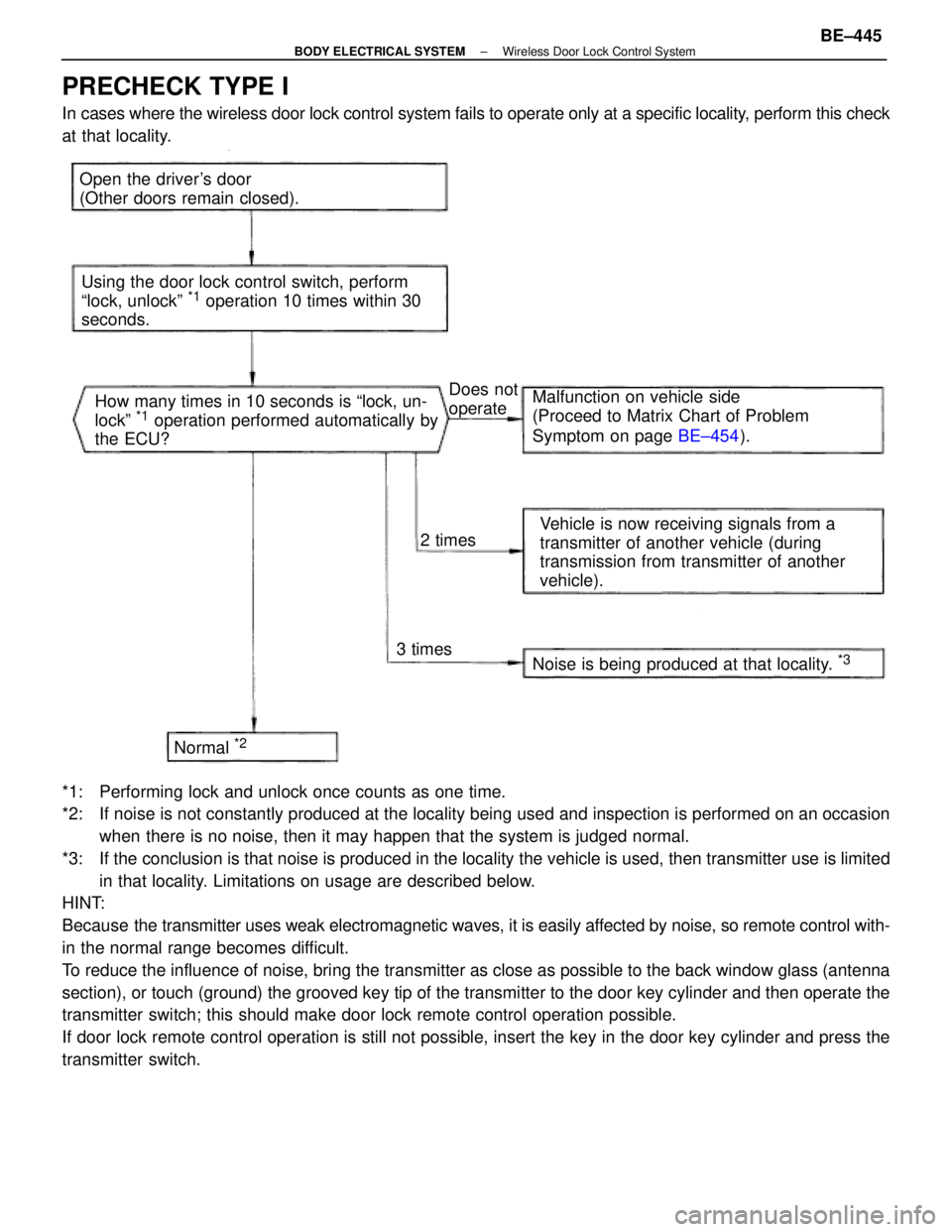Page 393 of 4087
±Memo±
AT00X±01
AT±30±
A304E (1UZ±FE) AUTOMATIC TRANSMISSION SHIFT LOCK SYSTEM
WhereEverybodyKnowsYourName
Page 394 of 4087
TROUBLESHOOTING
±
A304E (1UZ±FE) AUTOMATIC TRANSMISSION TROUBLESHOOTINGAT±31
WhereEverybodyKnowsYourName
Page 395 of 4087

HOW TO PROCEED WITH TROUBLESHOOTING
AT09N±0D
1. CUSTOMER PROBLEM ANALYSISUsing the customer problem analysis check sheet for reference, ask the c\
ustomer in as much detail as
possible about the problem.
2. CHECK AND CLEAR THE DIAGNOSTIC TROUBLE CODES (PRECHECK) Before confirming the problem symptom, first check if there are any diagnostic\
trouble malfunction codes
stored in memory. When there are malfunction codes, make a note of them, then clear them\
and proceed
to ª3. Problem Symptom Confirmationº.
3. PROBLEM SYMPTOM CONFIRMATION Confirm the problem symptoms.
4. SYMPTOM SIMULATION If the problem does not reappear, be sure to simulate the problem by mainly checking the circuits indica\
ted
by the diagnostic trouble code in step 2., using ªProblem Simulation me\
thodº.
5. DIAGNOSTIC TROUBLE CODE CHECK Check the diagnostic trouble codes. Check if there is abnormality in the\
sensors or the wire harness.
If a malfunction code is output, proceed to ª6. Diagnostic Trouble Code Chartº.
If the normal code is output, proceed to ª11. Matrix Chart of Problem Symptomsº.
Be sure to proceed to ª6. Diagnostic Trouble Code Chartº after the steps 2. and 3. are completed.
If troubleshooting is attempted only by following the malfunction code sto\
red in the memory is output, errors
could be made in the diagnosis.
6. DIAGNOSTIC TROUBLE CODE CHART If a malfunction code is confirmed in the diagnostic trouble code check, p\
roceed to the inspection proce-
dure indicated by the matrix chart for each diagnostic trouble code.
7. PRELIMINARY CHECK Carry out a preliminary check of the transmission oil level, throttle ca\
ble adjustment, etc.
8. SHIFT POSITION SIGNAL CHECK
Carry out the shift position signal check when the transmission gears do\
not up±shift, down±shift or lock±
up. This is to check the output condition from the ECM to each solenoid. If the r\
esults are NG, then it is
likely that the trouble is in the electrical system (particularly in th\
e sensors or the ECM).
Proceed to Part 1 (Electrical System) under ª11. Matrix Chart of Problem Symptomsº. If all the circuits speci-
fied in Part 1 are OK, check the ECM and replace it.
9. MECHANICAL SYSTEM TEST (Stall Test, Time Lag Test, Line Pressure Test, Accumulator Back Pressure Test)
If the malfunction is found in the stall test, time lag test, line press\
ure test or accumulator back pressure
test, check the parts indicated in the respective tests. If the problem is th\
at ªshift shock is largeº, perform
the accumulator back pressure test.
10. MANUAL SHIFTING TEST If the results of the manual driving test are NG, it is likely that the trouble is in the mechanical system or
hydraulic system. Proceed to Part 2 (Mechanical System) under the Matrix Chart \
of Problem Symptoms.
AT±32
±
A304E (1UZ±FE) AUTOMATIC TRANSMISSION TROUBLESHOOTING
WhereEverybodyKnowsYourName
Page 396 of 4087

11. MATRIX CHART OF PROBLEM SYMPTOMSIf the normal code is confirmed in the diagnostic trouble code check, perform inspection according to the
inspection order in the matrix chart of problem symptoms. Perform diagno\
sis of each circuit or part in the
order shown in the Matrix Chart. The Matrix Chart contains 3 chapters, Electronically Controlled Circuits
in Chapter 1, On±vehicle Inspection in Chapter 2 and Off±vehicle Inspection in Chapter 3. If all the circuits
indicated in Chapter 1 are normal, proceed to Chapter 2. If all the parts indicated i\
n Chapter 2 are normal,
proceed to Chapter 3. If all the circuits and parts in Chapter 1±Chapter 3 are normal and the trouble still
occurs, check and replace the ECM.
12. CIRCUIT INSPECTION Perform diagnosis of each circuit in accordance with the inspection order confirmed in 6. and 11. Judge
whether the cause of the problem is in the sensor, actuators, wire harness and connectors, or the ECM.
In some cases, the Flow Chart instructs that a throttle signal check, brak\
e signal check or kick down signal
check (in test mode) be performed. These are diagnosis functions used \
to check if signals are being input
correctly to the ECM.
13. PARTS INSPECTION Check the individual parts of the mechanical system and hydraulic system in t\
he order of the numbers indi-
cated in the Matrix Chart.
14. REPAIRS After the cause of the problem is located, perform repairs by following the i\
nspection and replacement pro-
cedures in this manual or '94 A340E and A341E Automatic Transmission Repair Manual (for LEXUS
SC400).
15. CONFIRMATION TEST
After completing repairs, confirm not only that the malfunction is eliminated\
, but also conduct a test drive,
etc., to make sure the entire electronically controlled transmission system i\
s operating correctly.
±
A304E (1UZ±FE) AUTOMATIC TRANSMISSION TROUBLESHOOTINGAT±33
WhereEverybodyKnowsYourName
Page 397 of 4087
P. AT±35P. AT±37 ~ AT±38
P. AT±47
P. AT±60 P. AT±39
P. AT±50
P. AT±59
P. AT±65
P. AT±66 P. AT±68
P. AT±70
P. AT±78 ± AT±120
P. AT±37 ~ AT±38
P. IN±26
P. AT±41
AT±34
±
A304E (1UZ±FE) AUTOMATIC TRANSMISSION TROUBLESHOOTING
WhereEverybodyKnowsYourName
Page 769 of 4087

PRECHECK TYPE I
In cases where the wireless door lock control system fails to operate only\
at a specific locality, perform this check
at that locality.
Open the driver's door
(Other doors remain closed).Using the door lock control switch, perform
ªlock, unlockº
*1 operation 10 times within 30
seconds.
How many times in 10 seconds is ªlock, un-
lockº
*1 operation performed automatically by
the ECU?
Noise is being produced at that locality.
*3
Vehicle is now receiving signals from a
transmitter of another vehicle (during
transmission from transmitter of another
vehicle).
Malfunction on vehicle side
(Proceed to Matrix Chart of Problem
Symptom on page
BE±454).
Does not
operate
2 times
3 times
Normal
*2
*1: Performing lock and unlock once counts as one time.
*2: If noise is not constantly produced at the locality being used and inspect\
ion is performed on an occasion when there is no noise, then it may happen that the system is judged normal.\
*3: If the conclusion is that noise is produced in the locality the vehicle is\
used, then transmitter use is limited in that locality. Limitations on usage are described below.
HINT:
Because the transmitter uses weak electromagnetic waves, it is easily affected by noise, so remote control with-
in the normal range becomes difficult.
To reduce the influence of noise, bring the transmitter as close as possib\
le to the back window glass (antenna
section), or touch (ground) the grooved key tip of the transmitter to\
the door key cylinder and then operate the
transmitter switch; this should make door lock remote control operation possible.
If door lock remote control operation is still not possible, insert the \
key in the door key cylinder and press the
transmitter switch.
±
BODY ELECTRICAL SYSTEM Wireless Door Lock Control SystemBE±445
WhereEverybodyKnowsYourName
Page 1261 of 4087

Coolant which is heated in the water jacket is pumped to the radiator, through which a cooling fan blows
air to cool the coolant as it passes through. Coolant which has been coo\
led is then sent back to the engine by
the water pump, where it cools the engine. The water jacket is a network of channels in the shell of the cylinder bloc\
k and cylinderhead through which
coolant passes. It is designed to provide adequate cooling through the cylinders and combus\
tion chambers
which become heated during engine operation.
RADIATOR The radiator performs the function of cooling the coolant which has pass\
ed through the waterjacket and
become hot, and it is mounted in the front of the vehicle. The radiator consis\
ts of an upper tank and lower tank,
and a core which connects the two tanks. The upper tank contains the inlet \
for coolant from the water jacket
and the filler inlet. It also has a hose attached through which excess cool\
ant or steam can flow. The lower tank
contains the outlet for coolant and drain plug. The core contains many t\
ubes through which coolant flows from
the upper tank to the lower tank as well as cooling fins which radiate heat\
away from the coolant in the tubes.
The air sucked through the radiator by the cooling fan, as well as the wind generated by the ve\
hicle's travel,
passes through the radiator, cooling the coolant. Models with automatic transmission include an aut\
omatic
transmission fluid cooler built into the lower tank of the radiator. A cooling fan is mounted behind radiator to assist
the flow of air through the radiator. When the coolant temperature is low, the fan operates slowly to help the warm
up, and when the coolant temperature becomes high, the fan speed is increas\
ed to provide the air flow required
for cooling.
RADIATOR CAP (on Reservoir Tank)
The radiator cap is a pressure type cap which seals the radiator, resulting in pressurization of the radiator
as the coolant expands. The pressurization prevents the coolant from boi\
ling even when the coolant tempera-
ture exceeds 100 5C (212 5F). A relief valve (pressurization valve) and a vacuum valve (negati\
ve pressure valve)
are built into the radiator cap. The relief valve opens and lets steam esca\
pe through the overflow pipe when
the pressure generated inside the cooling system exceeds the limit (coolant temperature: 110±120 5C
(230±248 5F) pressure; 29.4±98.1 kPa (0.3±1.0 kgf/cm2, 4.3±14.2 psi)). The vacuum v\
alve opens to alleviate
the vacuum which develops in the coolant system after the engine is stopped\
and the coolant temperature
drops.
RESERVOIR TANK The purpose of the reservoir tank is to catch coolant overflows created by \
volumetrix expansion when the
coolant temperature increases. The cap of the reservoir tank is a pressure type\
which prevents deterioration
of the LLC (Long Life Coolant) caused by contact with atmospheric air, increases vaporization performance and
reduces loss of the coolant volume.
WATER PUMP The water pump is mounted on the front of the cylinder block and driven by t\
he reverse side of the timing
belt.
THERMOSTAT The thermostat has a wax type by±pass valve and is mounted in the wat\
er inlet housing. The thermostat
begins to open at the temperature of 80 5C (180 5F). When the coolant temperature is low, the valve closes to
prevent coolant flow to the radiator, thus permitting the engine to warm up rapidly. When the by±pass valve
opens the by±pass circuit, the engine coolant continues to circulate \
inside the engine, quickly and uniformly
warming up to the appropriate temperature. When the coolant temperature is high\
, the valve opens and coolant
flows to the radiator where it is cooled. When the wax inside the thermostat \
is heated, it expands and thus
creates pressure which overpowers the force of the spring which keeps the valve\
closed. When the wax cools,
its contraction causes the force of the spring to take effect once more, closing the valve.
ELECTRONICALLY CONTROLLED HYDRAULIC COOLING FAN (See page CO±22)
±
COOLIING SYSTEM DescriptionCO±3
WhereEverybodyKnowsYourName
Page 1282 of 4087
9. FILL ENGINE WITH COOLANT (See page CO±7)
10. FILL COOLING FAN RESERVOIR TANK WITH FLUID (See pages CO±23 and 24)
11. CHECK AUTOMATIC TRANSMISSION FLUID LEVEL
(See page MA±11)
NOTICE: Do not overfill.
12. START ENGINE AND CHECK FOR LEAKS
13. INSTALL ENGINE UNDER COVER
±
COOLIING SYSTEM RadiatorCO±21
WhereEverybodyKnowsYourName